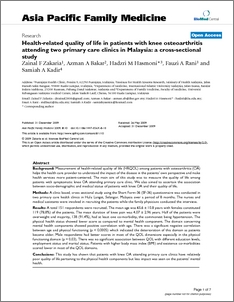Zakaria, Zainal F. and Bakar, Azman A. and Hasmoni, Mohamed Hadzri and Abdul Rani, Mohammed Fauzi and Kadir, Salmiah A.
(2009)
Health-related quality of life in patients with knee osteoarthritis attending two primary care clinics in Malaysia: a cross-sectional study.
Asia Pacific Family Medicine, 8 (10).
![[img]](http://irep.iium.edu.my/style/images/fileicons/application_pdf.png)  Preview |
|
PDF (Health-related quality of life in patients with knee osteoarthritis attending two primary care clinics in Malaysia)
Download (228kB)
| Preview
|
Abstract
BACKGROUND: Measurement of health-related quality of life (HRQOL) among patients with osteoarthritis (OA) helps the health care provider to understand the impact of the disease in the patients' own perspective and make health services more patient-centered. The main aim of this study was to measure the quality of life among patients with symptomatic knee OA attending primary care clinic. We also aimed to ascertain the association between socio-demographic and medical status of patients with knee OA and their quality of life.
METHODS: A clinic based, cross sectional study using the Short Form-36 (SF-36) questionnaire was conducted in two primary care health clinics in Hulu Langat, Selangor, Malaysia over a period of 8 months. The nurses and medical assistants were involved in recruiting the patients while the family physicians conducted the interview.
RESULTS: A total 151 respondents were recruited. The mean age was 65.6 +/- 10.8 years with females constituted 119 (78.8%) of the patients. The mean duration of knee pain was 4.07 +/- 2.96 years. Half of the patients were overweight and majority, 138 (91.4%), had at least one co-morbidity, the commonest being hypertension. The physical health status showed lower score as compared to mental health component. The domain concerning mental health components showed positive correlation with age. There was a significant negative correlation between age and physical functioning (p < 0.0005) which indicated the deterioration of this domain as patients became older. Male respondents had better scores in most of the QOL dimensions especially in the physical functioning domain (p = 0.03). There was no significant association between QOL with different education levels, employment status and marital status. Patients with higher body mass index (BMI) and existence co-morbidities scored lower in most of the QOL domains.
CONCLUSIONS: This study has shown that patients with knee OA attending primary care clinics have relatively poor quality of life pertaining to the physical health components but less impact was seen on the patients' mental health.
Actions (login required)
 |
View Item |


 Download Statistics
Download Statistics Download Statistics
Download Statistics